Link to Pubmed [PMID] – 20351136
Infect. Immun. 2010 Jun;78(6):2571-83
When confronted with metabolic stress, replicative Legionella pneumophila bacteria convert to resilient, infectious cells equipped for transmission. Differentiation is promoted by the LetA/LetS two-component system, which belongs to a family of signal-transducing proteins that employ a four-step phosphorelay to regulate gene expression. Histidine 307 of LetS was essential to switch on the transmission profile, but a threonine substitution at position 311 (T311M) suggested a rheostat-like function. The letS(T311M) bacteria resembled the wild type (WT) for some traits and letS null mutants for others, whereas they displayed intermediate levels of infectivity, cytotoxicity, and lysosome evasion. Although only 30 to 50% of letS(T311M) mutants became motile, flow cytometry determined that every cell eventually activated the flagellin promoter to WT levels, but expression was delayed. Likewise, letS(T311M) mutants exhibited delayed induction of RsmY and RsmZ, regulatory RNAs that relieve CsrA repression of transmission traits. Transcriptional profile analysis revealed that letS(T311M) mutants expressed the flagellar regulon and multiple other transmissive-phase loci at a higher cell density than the WT. Accordingly, we postulate that the letS(T311M) mutant may relay phosphate less efficiently than the WT LetS sensor protein, leading to sluggish gene expression and a variety of phenotypic profiles. Thus, as first described for BvgA/BvgS, rather than acting as on/off switches, this family of two-component systems exhibit rheostat activity that likely confers versatility as microbes adapt to fluctuating environments.

